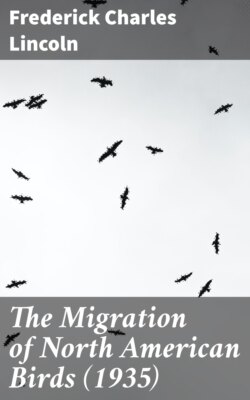Читать книгу The Migration of North American Birds (1935) - Frederick Charles Lincoln - Страница 12
На сайте Литреса книга снята с продажи.
MOVEMENTS OF SPECIES AND GROUPS
ОглавлениеTable of Contents
Some species begin their fall migrations early in July, and in some parts of the country distinct southward movements can be detected from then until the beginning or middle of winter. For example, many shore birds start south in the early part of July, while the goshawks (Astur atricapillus), snowy owls (Nyctea nyctea), redpolls (Acanthis linaria), Bohemian waxwings (Bombycilia garrula), and many others do not leave the North until forced to do so by the advent of severe winter weather or by lack of the customary food. Thus, an observer in the northern part of the United States may record an almost unbroken southward procession of birds from midsummer to winter, and note some of the returning migrants as early as the middle of February. Purple martins (Progne subis) have been known to arrive in Florida late in January on their way north, and the northern movement may continue among late arrivals into the first week of June. In some species the migration is so prolonged that the first arrivals in the southern part of the breeding range will have performed their parental duties while others of that species are still on their way north.
A study of these facts indicates that sometimes there exists a very definite relationship between what we may term northern and southern groups of individuals of the same species. A supposition, on which additional banding work is expected later to give definite facts, is that in the case of some species that have an extensive latitudinal breeding range and a normal migration, the individuals that nest farthest south migrate first in fall and proceed to the southern part of the winter range; those that occupy the central parts of the breeding range migrate next, and travel to regions in the winter range north of those occupied by the first group; and finally the individuals breeding farthest north are the last to begin their fall migration and these remain farthest north during the winter. In other words, this theory supposes that the southward movement of the species is normally such that the different groups maintain their relative latitudinal positions, both spring and fall.
B4503M
Figure 2.—Summer and winter homes of the black-and-white warbler. A very slow migrant, as the birds nesting in the northern part of the country take 50 days to cross the breeding range. The rapidity of their advance is shown in figure 3.
The black-and-white warbler (Mniotilta varia) furnishes an example. The breeding range of this bird extends west and northwest from South Carolina and New Brunswick as far as Great Bear Lake in northwestern Canada (fig. 2). The bird spends the winter in southern Florida, the West Indies, central Mexico, Central America, and northwestern South America. In the southern part of its breeding range it is nesting in April, but the summer residents of New Brunswick do not reach their breeding grounds before the middle of May. Therefore, about 50 days are required for these northbound birds to cross the breeding range, and if 60 days be allowed for nest building, egg laying, incubation, care of the young, and molt, they would not be ready to start southward before the middle of July (fig. 3). Then another 50-day trip south, and the earliest migrants from the northern areas would reach the Gulf coast in September. But both adults and young have been observed at Key West, Fla., by the middle of July, and on the northern coast of South America by August 21. Since the birds at Key West were fully 500 miles south of the breeding-range, it is evident that they must have come from the southern part of the nesting area.
B4504M
Figure 3.—Isochronal migration lines of the black-and-white warbler, showing a slow and uniform migration, the advance across the United States being apparently only about 20 miles a day.
Many similar cases might be mentioned, such as the black-throated blue warblers (Dendroica caerulescens), which are still observed in the mountains of Haiti in the middle of May when others of the species are en route through North Carolina to breeding territory in New England or have even reached that region. Redstarts (Setophaga ruticilla) and yellow warblers (D. aestiva), evidently the more southern breeders in each case, are seen returning southward on the northern coast of South America just about the time that the earliest of those breeding in the North reach Florida on their way to winter quarters.
B2282M
Figure 4.—The Kentucky warbler, a night migrant, in traveling to its winter quarters in Central America and northwestern South America, uses route no. 5, figure 20.
